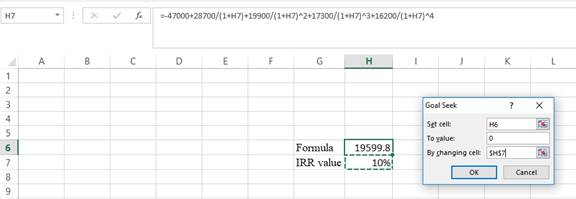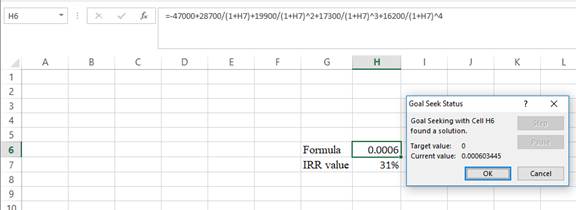
Concept explainers
LO1, LO3, LO4, LO6 15. Comparing Investment Criteria. Consider the following two mutually exclusive projects:
| Year | Cash Flow (A) | Cash Flow (B) |
| 0 | –$235,000 | –$47,000 |
| 1 | 29,000 | 28,700 |
| 2 | 45,000 | 19,900 |
| 3 | 51,000 | 17,300 |
| 4 | 325,000 | 16,200 |
Whichever project you choose, if any, you require a return of 13 percent on your investment.
a. If you apply the payback criterion, which investment will you choose? Why?
b. If you apply the
c. If you apply the
d. If you apply the profitability index criterion, which investment will you choose? Why?
e. Based on your answers in parts (a) through (d), which project will you finally choose? Why?
a)
To compute: The payback period.
Introduction:
Capital budgeting is a process, where the business identifies and assesses potential investments or expenses that are larger (in general).
Answer to Problem 15QP
Explanation of Solution
Given information:
The cash flows for two mutually exclusive projects are $29,000, $45,000, $51,000, $325,000 for Project A for year 1, year 2, year 3, and year 4 respectively. Project A has an initial investment of $235,000. The cash flows of Project B are $28,700, $19,900, $17,300, and $16,200 for year 1, year 2, year 3, and year 4 respectively. The initial investment for Project B is $47,000. The rate of return is 13%.
Formula to compute the payback period of a project:
Compute the payback period of a project for Project A:
Hence, the payback period is 3.34 years for Project A.
Compute the payback period of a project for Project B:
Hence, the payback period is 1.92 years for Project B.
b)
To compute: The NPV (Net Present Value).
Introduction:
Capital budgeting is a process, where the business identifies and assesses potential investments or expenses that are larger (in general).
Answer to Problem 15QP
Explanation of Solution
Given information:
The cash flows for two mutually exclusive projects are $29,000, $45,000, $51,000, $325,000 for Project A for year 1, year 2, year 3, and year 4 respectively. Project A has an initial investment of $235,000. The cash flows of Project B are $28,700, $19,900, $17,300, and $16,200 for year 1, year 2, year 3, and year 4 respectively. The initial investment for Project B is $47,000. The rate of return is 13%.
Formula to calculate the NPV:
Calculate the NPV for Project A:
Hence, the NPV for Project A is $60,579.46.
Calculate the NPV for Project B:
Hence, the NPV for Project B is $15,908.38.
c)
To compute: The IRR for the project.
Introduction:
Capital budgeting is a process, where the business identifies and assesses potential investments or expenses that are larger (in general).
Answer to Problem 15QP
Explanation of Solution
Given information:
The cash flows for two mutually exclusive projects are $29,000, $45,000, $51,000, $325,000 for Project A for year 1, year 2, year 3, and year 4 respectively. Project A has an initial investment of $235,000. The cash flows of Project B are $28,700, $19,900, $17,300, and $16,200 for year 1, year 2, year 3, and year 4 respectively. The initial investment for Project B is $47,000. The rate of return is 13%.
Equation of IRR of Project A:
Compute IRR for Project A using a spreadsheet:
Step 1:

- Type the equation of NPV in H6 in the spreadsheet and consider the IRR value as H7.
Step 2:

- Assume the IRR value as 10%.
Step 3:

- In the spreadsheet, go to data and select the what-if analysis.
- In the what-if analysis, select goal seek.
- In set cell select H6 (the formula).
- The “To value” is considered as 0 (the assumption value for NPV).
- The H7 cell is selected for the by changing cell.
Step 4:

- Following the previous step click OK in the goal seek. The goal seek status appears with the IRR value.
Step 5:

- Thevalue appears to be 21.0164258735852%.
Hence, the IRR value is 21.02%.
Equation of IRR of Project B:
Compute IRR for Project B using a spreadsheet:
Step 1:

- Type the equation of NPV in H6 in the spreadsheet and consider the IRR value as H7.
Step 2:

- Assume the IRR value as 10%.
Step 3:

- In the spreadsheet, go to data and select the what-if analysis.
- In the what-if analysis, select goal seek.
- In set cell, select H6 (the formula).
- The “To value” is considered as 0 (the assumption value for NPV).
- The H7 cell is selected for the by changing cell.
Step 4:

- Following the previous step, click OK in the goal seek. The goal seek status appears with the IRR value.
Step 5:

- Thevalue appears to be 30.5678172386103%.
Hence, the IRR value is 30.57%.
d)
To compute: The profitability index.
Introduction:
Capital budgeting is a process, where the business identifies and assesses potential investments or expenses that are larger (in general).
Answer to Problem 15QP
Explanation of Solution
Given information:
The cash flows for two mutually exclusive projects are $29,000, $45,000, $51,000, $325,000 for Project A for year 1, year 2, year 3, and year 4 respectively. Project A has an initial investment of $235,000. The cash flows of Project B are $28,700, $19,900, $17,300, and $16,200 for year 1, year 2, year 3, and year 4 respectively. The initial investment for Project B is $47,000. The rate of return is 13%.
Formula to compute the profitability index:
Compute the profitability index for Project A:
Hence, the profitability index for Project A is $1.258.
Compute the profitability index for Project B:
Hence, the profitability index for Project B is $1.338.
e)
To discuss: The project that Person X will select with a reason.
Introduction:
Capital budgeting is a process, where the business identifies and assesses potential investments or expenses that are larger (in general).
Explanation of Solution
In this case, the criteria of NPV denote that Project A must be accepted, while payback period, profitability index, and IRR denote that Project B must be accepted. The overall decision must be based on the NPV as it does not have the ranking problem when compared with the other techniques of capital budgeting. Hence, Project A must be accepted.
Want to see more full solutions like this?
Chapter 8 Solutions
ESSENTIALS CORPORATE FINANCE + CNCT A.
- Could you please help to explain the DMAIC phases and how a researcher would use them to conduct a consulting project? What is a measure process performance and how to analyze the process? What is an improve process performance and how the control improves process and future process performance?arrow_forwardConsider the two stocks below. Graph the frontier of combinations of the two stocks. Show the effect on the frontier of varying the correlation from −1 to +1. 1 2 3 Mean A B C D TWO STOCKS Varying the correlation coefficient Stock A Stock B 3.00% 8.00% 4 Sigma 15.00% 22.00% 5 Correlation 0.3000 Farrow_forwardLindsay is 30 years old and has a new job in web development. She wants to make sure that she is financially sound by the age of 55, so she plans to invest the same amount into a retirement account at the end of every year for the next 25 years. (a) Construct a data table in Excel that will show Lindsay the balance of her retirement account for various levels of annual investment and return. If Lindsay invests $10,000 at return of 6%, what would be the balance at the end of the 25th year? Note that because Lindsay invests at the end of the year, there is no interest earned on the contribution for the year in which she contributes. Round your answer to a whole dollar amount. $ (b) Develop a two-way table for annual investment amounts of $5,000 to $20,000 in increments of $1,000 and for returns of 0% to 12% in increments of 1%. From the 2-way table, what are the minimum annual investments Lindsay must contribute for annual rates ranging from 6% to 11%, if she wants to…arrow_forward
- Does Airbnb have any impaired assets? If so, what are they?arrow_forward1. Consider two assets with the following returns: State Prob. of state R1 R2 1 2/3 .03 .05 2 1/3 .09 .02arrow_forwardBright wood! Seating sells reclining chairs for $55.00 per unit. The variable cost is 322 per unit. Each reclining chair requires 5 direct labor hours and 3 machine hours to produce. ibution margin pemachine hon Wrightwood Manufacturing has a break-even point of 1,500 units. The sales price per unit is $18. and the variable cost per us $13. If the company sells 3,500 units, what will its net income be? Crestwood Industries provides the following budget data for its Processing Department for the year 2022: ⚫ Manufacturing Overhead Costs=250 ⚫ Direct Labor Costs $1,234,500 Determine the manufacturing overhead application rate under the base of Direct Labor Costs. Modesto Accessories manufactures two types of wallets leather and canvas. The company allocates manufacturing overhead using a single plant wide rate with direct labor cost as the allocation base. $48 Estimated Overhead Costs = 30,600 Direct Labor Cost per Leather Wallet Direct Labor Cost per Canvas Wallet = $52 Number of…arrow_forward

 Intermediate Financial Management (MindTap Course...FinanceISBN:9781337395083Author:Eugene F. Brigham, Phillip R. DavesPublisher:Cengage Learning
Intermediate Financial Management (MindTap Course...FinanceISBN:9781337395083Author:Eugene F. Brigham, Phillip R. DavesPublisher:Cengage Learning EBK CONTEMPORARY FINANCIAL MANAGEMENTFinanceISBN:9781337514835Author:MOYERPublisher:CENGAGE LEARNING - CONSIGNMENT
EBK CONTEMPORARY FINANCIAL MANAGEMENTFinanceISBN:9781337514835Author:MOYERPublisher:CENGAGE LEARNING - CONSIGNMENT



